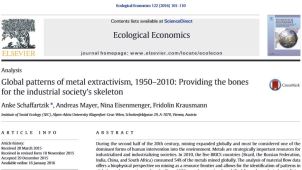
By Anke Schaffartzik, Andreas Mayer, Nina Eisenmenger and Fridolin Krausmann.
Mining operations have high social and environmental impact potential, and the increasing extraction and use of metals is likely to fuel socio-ecological conflicts. The Viennese EJOLT team has published a global, quantitative analysis of metal flows that provides insights on the patterns and potential consequences of (neo-)extractivism with regard to metals. Such an analysis allows activists, researchers, and local populations who are struggling with negative impacts from mining operations to see similar patterns of drivers and pressures in other cases, too. The combination of insights from local and global studies will improve understanding of the resulting potential for conflict and of the precursors to necessary change.
Abstract
During the second half of the 20th century, mining expanded globally and must be considered one of the dominant forms of human intervention into the environment. Metals are strategically important resources for industrialized and industrializing societies. In 2010, the five BRICS countries (Brazil, the Russian Federation, India, China, and South Africa) consumed 54% of the metals mined globally. The analysis of material flow data offers a biophysical perspective on mining as a resource frontier and allows for the identification of patterns in global metals extraction and trade. Since 1950, metal extraction has shifted from the early industrializing countries into the emerging economies. In 2010, only 6% of metals mined stemmed from Europe or North America while 76% were extracted in four countries (Australia, China, India, and Brazil). In the countries hosting large-scale mining operations, socio-ecological pressure ensues the so-called extractivist development path is common. High rates of metal deposit depletion mean that today’s metal extractors and exporters may depend on imports of metal from anthropogenic deposits (stocks in buildings, infrastructure, and durable products) in the future. The extractivist path and the shifting of metals from natural to anthropogenic deposits are both associated with potential for conflict.
How to Cite
Anke Schaffartzik, Andreas Mayer, Nina Eisenmenger, Fridolin Krausmann, Global patterns of metal extractivism, 1950–2010: Providing the bones for the industrial society’s skeleton. Ecological Economics, Volume 122, February 2016, pp.101-110
Link
http://www.sciencedirect.com/science/article/pii/S0921800915004899
Key words
Material flow accounting, Mining, Metals, Trade, Extractivism

The project ENVJUSTICE has received funding from the European Research Council (ERC) under the European Union’s Horizon 2020 research and innovation programme (grant agreement No. 695446)